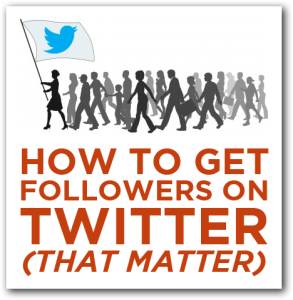 Do you want to get more followers on Twitter? Build an audience? Drive more qualified leads to your site? Grow your business?
Do you want to get more followers on Twitter? Build an audience? Drive more qualified leads to your site? Grow your business?
Then you’re doing it wrong.
Yes, Twitter is a powerful tool for attracting an audience, but if you’re looking to use Twitter to build your business, you have to realize that it’s not just a numbers game.
Your goal is to attract followers in the same way that you target certain audiences for your business.
I’m not being cold-hearted here, I’m just suggesting that if you want to use Twitter for business, you’ll need to be strategic in how you approach it, and how you go about gathering followers.
If you sell women’s dresses you don’t spend a lot of time targeting men, do you? If you’re a barber, you wouldn’t take out ads in Bald is Beautiful Quarterly, would you? And if you’re a landscaper you wouldn’t slide brochures under apartment doors, right?
The same is true with Twitter. While there’s nothing wrong with bald men knowing about your barber shop (they may recommend you to a friend), you want to focus on the people you can help most, and who will engage you for business.
In this article you’ll learn the steps to building a Twitter following that builds your business.
Create a compelling profile.
While mystique may be one of Sally Hogshead’s seven triggers for fascination, it won’t work for most businesses or professionals on Twitter.
People are more likely to follow you or your business (but really, they’re more likely to follow a person) if you’re transparent, approachable and real.
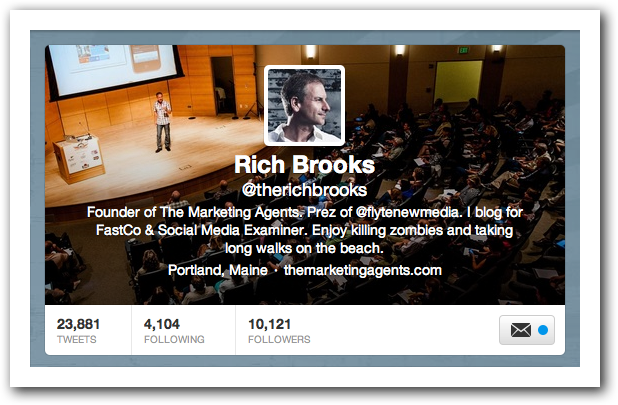
Here arethe components of a compelling profile:
- Twitter Handle: If it’s available, choose a Twitter handle that’s as close to your name as possible, or representative of what you do. You’ve only got 15 characters, so be brief. If you already have an established brand online, try and duplicate it in your handle. Avoid underscores as they add unnecessary characters (eating up your 140 characters) and can require up to three clicks on a mobile devise for someone to mention you.
- Your Name: Whenever possible use your name (or DJ name) so people can find and recognize you.
- Email address: Use your primary business email when signing up for Twitter and allow people to find you by email. Although no one sees your email address, it will increase the likeliness that your real world contacts can find you.
 Profile photo: Use a well-cropped, square picture of your face. Forget about that picture of your cat, your favorite sports team or the one where your friend’s arm is around your shoulder but they’re cropped out. You want people to recognize you, and the avatar is small, so focus on your face. And smile! You want to be approachable, don’t you? Twitter will automatically scale your photo down, but you should upload a larger photo so people can click on it and see the bigger version.
Profile photo: Use a well-cropped, square picture of your face. Forget about that picture of your cat, your favorite sports team or the one where your friend’s arm is around your shoulder but they’re cropped out. You want people to recognize you, and the avatar is small, so focus on your face. And smile! You want to be approachable, don’t you? Twitter will automatically scale your photo down, but you should upload a larger photo so people can click on it and see the bigger version.- Bio: You only have 160 characters to be interesting, so cut to the chase. Create a compelling bio that gently explains why you’re follow-worthy. This is a place to show your personality, so hopefully you have one. You can also include other Twitter accounts you use here by including them with the @ sign.
- Location: I’m a big fan of including your location, because you’re immediately more interesting to local people. Even if your business isn’t geographically-challenged, a location makes you feel more real and tangible.
- URL: Twitter allows you to link to an outside resource, so link to somewhere people can learn more about you if they wish. I’d recommend a blog or website, but use the platform where you’re most visible and have a good sized following.
- Header image: This addition to the Twitter profile allows you to use an image that will continue to build your brand and set the tone for your tweets. Currently I use a photo of me presenting to an audience. What sells you as an expert in your field?
- Background image: Don’t use one of Twitter’s generic background images. While it’s not as bad as having an egg for your photo, it makes it look like you don’t take Twitter seriously. Find a big image that supports your brand and message, or just a cool pattern that’s not one thousands of other Twitter users have.
Find and follow the right people.
Stephen Covey famously said “seek first to understand, then to be understood.”
Likewise, seek first to follow, then to be followed. This is especially true when you’re first starting out.
Find local people.
If your audience is local, you’ll need to follow local people. Easiest way to do this is to visit the advanced search on Twitter and put in your location.

You can further refine your results with keywords or hashtags, like “hungry” or “#smallbiz.”
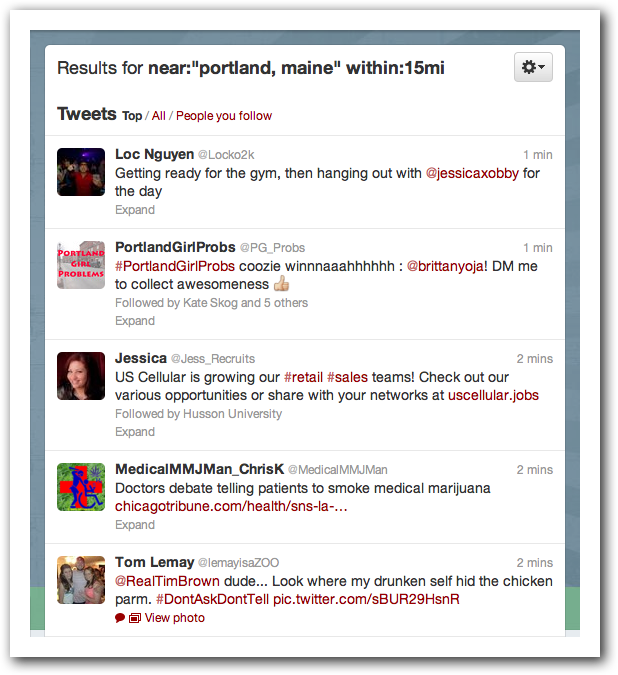
Find prospective customers.
You can also use Twitter search to find prospective customers. If you had a golf product, a search on golf, Titleist or Tiger Woods would uncover hundreds (if not thousands) of potential people to follow.
Now, just because these people mentioned Tiger Woods doesn’t mean they want to buy from you or even follow you back.
However, most people have their Twitter accounts configured that Twitter will send them an email for each new follower. If you have a compelling profile (remember that last section), you’ve got a better chance of gaining a valuable follower.
Use 3rd Party Tools
You can use 3rd party tools like Wefollow and Twellow to find your audience on Twitter, whether they’re moms or comptrollers.
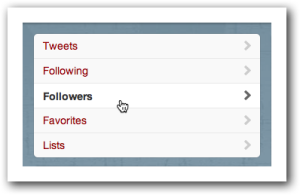 Check out your competitors’ followers.
Check out your competitors’ followers.
Visit the Twitter profiles of people who are similar to you or your business and take a look at who’s following them by clicking on the Followers link.
These might be people you want to engage with as well.
Engage people on Twitter
While many people automatically follow everyone back, and others will follow you because you appear interesting, not everyone will immediately jump on your bandwagon.
Personally, I don’t feel that a “follow back” is required Twitter etiquette. Just because you subscribe to my email newsletter doesn’t mean I am expected to subscribe to yours, right?
These days I wait for new followers to engage me before I follow them back.
To increase the chances of people following you back, you need to engage them on Twitter. Here are some tips:
- Respond to their tweets. When people you follow ask questions or start a conversation, join in. You’re not crashing their party, they’re looking for engagement.
- Mention them by handle. When you use someone’s handle on twitter (like @therichbrooks), that tweet shows up in their Mentions. This greatly increases the chances of them seeing it–and you–even if they don’t follow you yet.
- Retweet them. If they’ve tweeted something of value, retweet them. This also shows up in their Mentions, increasing your visibility to them.
- Join Twitter chats. There are many regular, recurring chats on Twitter. There’s usually a hashtag that the group uses, whether they’re talking about comic books, marketing or ADHD. This is a good way to find your tribe.
Share valuable content.
For some people, this is the most challenging part. For beginners (or re-beginners), they stare at that empty update box like they’ve been tasked with writing the great American novel. That their tweet needs to be perfect. That they will be judged on each tweet.
It’s only 140 characters, people! Get over it!
The beauty of Twitter is how fast paced it is. If you tweet out a complete #fail, don’t worry. Just keep tweeting and it will start to become more natural.
To find valuable content, set up a Google Alert for some of your best content topics. That should give you a steady stream of good blog posts and articles to share. Then you can use a tool like Hootsuite or Tweetdeck to schedule some tweets so you’re not blasting out 10 tweets in a row, then going silent for 24 hours.
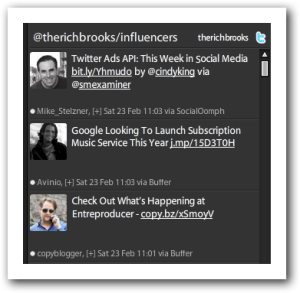 You should also follow some industry experts, because they often share some of the best content out there. This makes your job easier, because you can just retweet or otherwise share their best finds.
You should also follow some industry experts, because they often share some of the best content out there. This makes your job easier, because you can just retweet or otherwise share their best finds.
I recommend setting up a Twitter list to follow a group of influencers in your industry, or in the industries of your customers.
Twitter lists allow you separate the wheat from the chaff, and improve your signal to noise ratio. Whether at Twitter.com or in a 3rd party tool like TweetDeck (as shown here), you can more easily find the best content from your own curated list.
Remember: value is in the eye of your audience. If you’re using Twitter for business, you need to continually be asking yourself, “is this content valuable to my ideal customer?”
That being said, you also need to develop a personality on Twitter. People choose to follow and engage with people more often than faceless corporations. If your Twitter feed looks like it’s a business posing as a person, you won’t get the same level of interaction.
Use the Pareto Principle when tweeting.
Also known as the 80/20 rule, you should be sharing non-promotional content 80% of the time, and self-promotional content no more than 20% of the time.
Twitter is like a cocktail party, and no one wants to get cornered by that guy who does nothing but talk about himself. And on Twitter, it’s easy to get out of the corner. You just stop paying attention or unfollow someone.
Promote other people’s work and activity and you’ll find that they will go out of their way to share your content when the time comes, even without you asking.
Use hashtags wisely.
Hashtags provide a valuable service on Twitter; they allow people to organize tweets around a specific topic, like #hockey or #knitting.
Many users search for hashtags to follow the conversation, which is why a strategic use of adding hashtags to your tweets will attract new followers who may not have found you otherwise.
Just add appropriate hashtags after a tweet by using # followed immediately by an alphanumeric string. No spaces or punctuation, please! Twitter will take care of the rest.

Consider Promoted Accounts and Tweets
Twitter offers advertising options to promote either an account or specific tweets using a pay-per-click model.
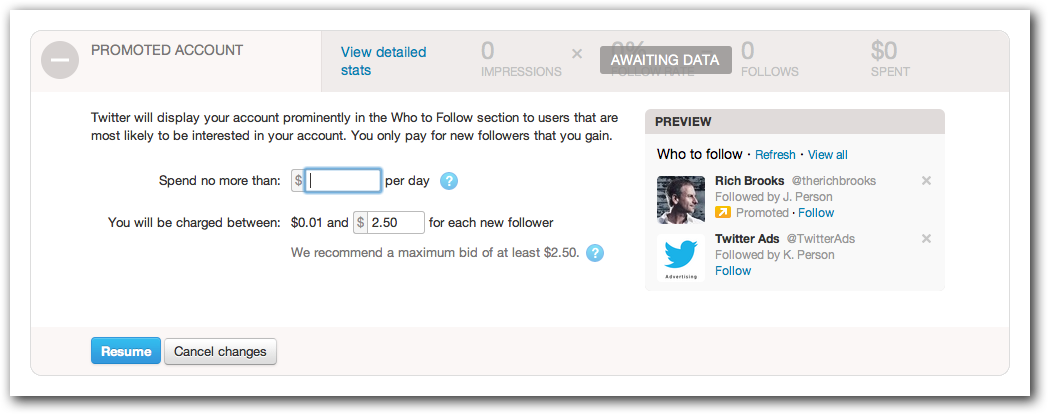
To quickly increase your reach, you may want to set a reasonable budget to either promote your account or specific tweets. I’ve used promoted tweets to drive traffic for webinar signups and even blog posts with some success.
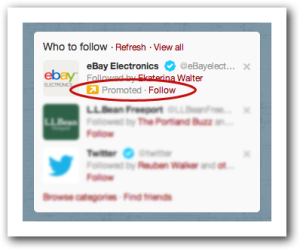 Promoted tweets show up in the feed of your followers and non-followers alike based on their interests.
Promoted tweets show up in the feed of your followers and non-followers alike based on their interests.
Promoted accounts show up in the Who to follow section with a little Promoted account note.
In both cases, you only pay when someone takes an action (following you or clicking on your tweet, for example.)
Promote your Twitter activity off Twitter.
If you’ve decided that Twitter is going to be part of your ongoing digital marketing, then you’ll need to promote that activity in other places you already have an audience.
That could mean creating a link in your email signature. Talking it up on Facebook. Linking to it from your LinkedIn profile. Or adding a Twitter app to your blog or website.
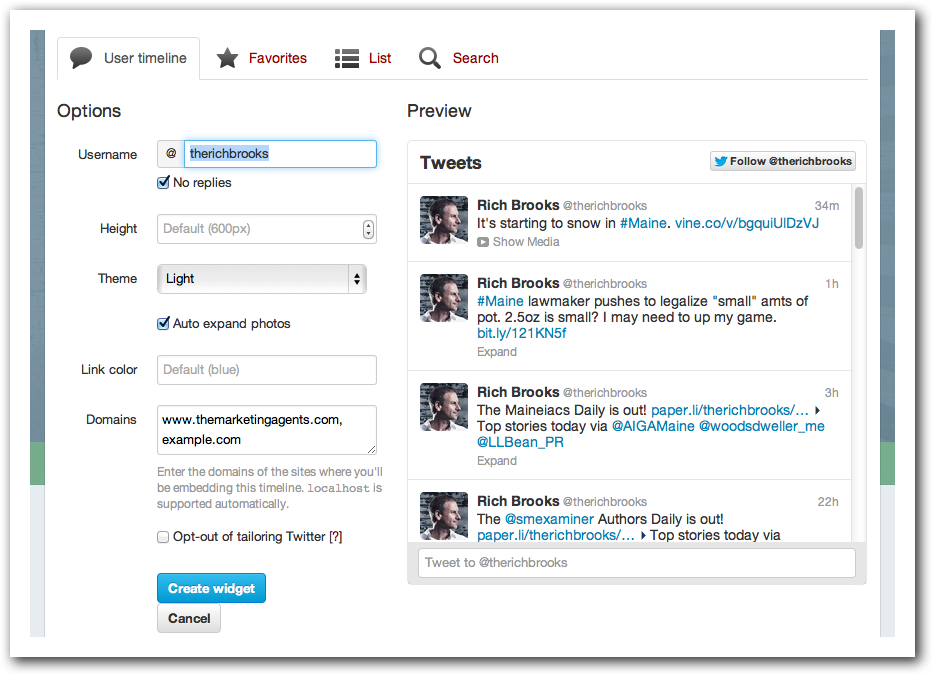
Also, if you’re a thought leader in your industry, consider writing an article on how Twitter can help restaurant owners, or candle makers, or stained glass artists, and encourage them to follow you on Twitter to learn more.
Commit to the Twitter.
Unless you’re a celebrity, you shouldn’t expect thousands of followers right out of the gate.
Instead, you should plan on building your presence and your audience organically over time. At the beginning it may only be one new follower a day. Celebrate those small wins!
Over time, however, as you share great content and engage with people on Twitter, you’ll see more people gravitate to you, follow you, and start engaging with you.
The trick is to commit to Twitter. That means carving time out of each day to share valuable content, respond to any mentions, retweet some of the people you’re following, and otherwise engage with Twitter.
It means being patient and understanding that overnight success only comes after months or even years of hard work and commitment.
Next Steps
What tactics or techniques have you used to build your own following on Twitter? Or what have you struggled with most with your own Twitter account?
Share them in the comments below, and be sure to include a link back to your own Twitter account so we can follow you!
If you thought this was helpful, and you want more advice on marketing your business on Twitter or through other channels, please make sure you’re signed up for our free email updates.
They’re free! 🙂